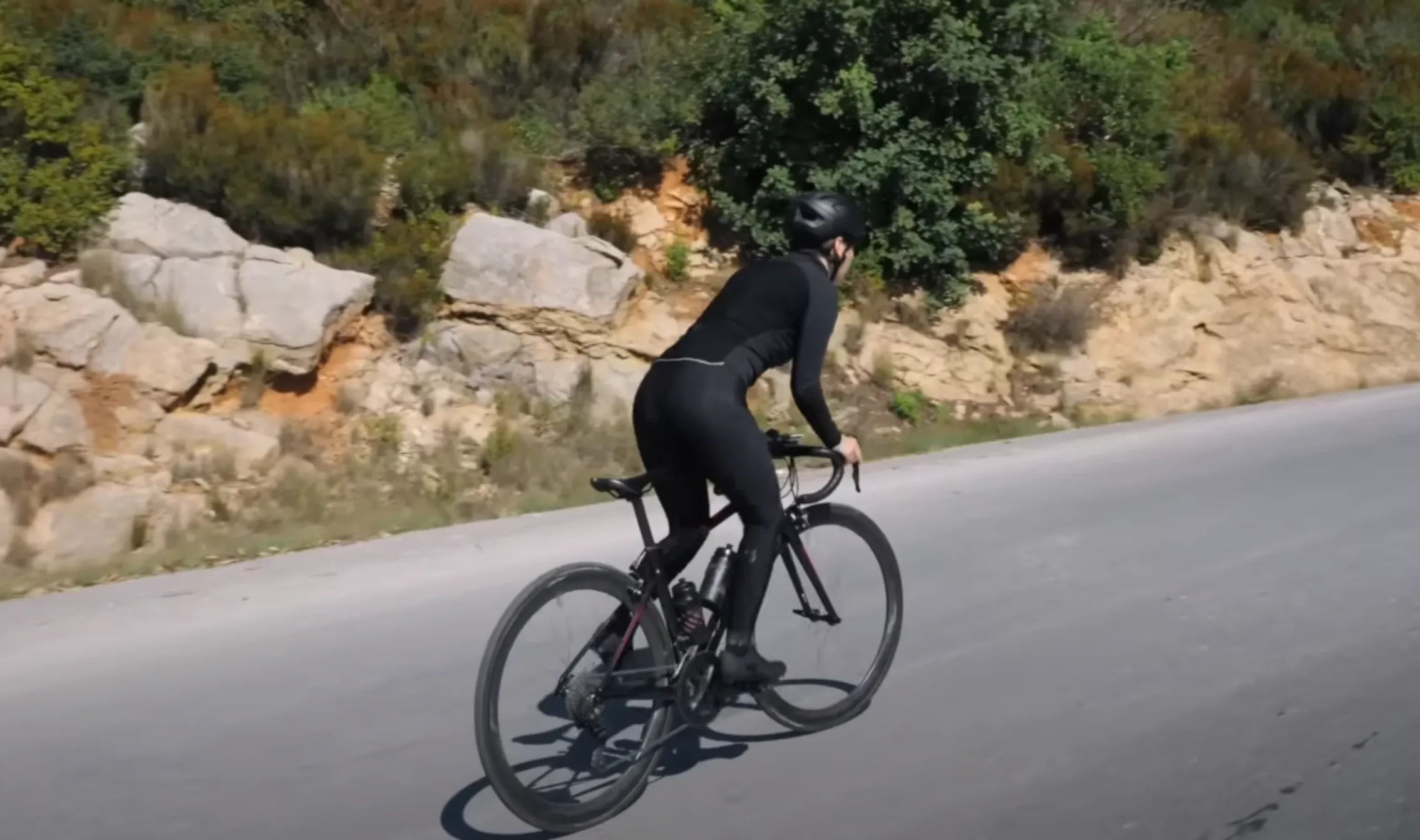Cycling has emerged as a highly effective weight management method. It boosts metabolism, facilitates muscle growth, and aids in burning excess body fat, making it a comprehensive and beneficial exercise choice for individuals seeking to achieve their weight goals.
Cycling develops lower body muscles, enhances leg shape and strength, and tones the arms. It helps with weight loss, has a low impact on joints, and improves muscle appearance and growth. Cycling also strengthens thighs, calves, and buttocks while achieving a flat stomach.
In this blog post, we will explore cycling’s effect on body shape and its psychological benefits. Discover how this enjoyable workout strengthens the legs, tunes the core, and boosts heart health, all while enhancing mental well-being.
Effects Of Cycling On Body Shape: 11 Physical Changes
Cycling offers more than outdoor enjoyment or eco-friendly commuting; it is a superb workout that can sculpt your physique. Cycling can reshape your body, toning muscles and transforming your physique.
This exploration delves into cycling’s impact on body composition and holistic fitness. It looks at how cycling can shape your body and improve your health.
Legs and Lower Body: The Cycling Effect

When you cycle regularly, your legs and lower body undergo noticeable changes. This is because it involves multiple lower-body muscle groups. Here’s what happens:
Quadriceps: Powering Your Pedal
- Growth and Strengthening: Your quadriceps, or the front thigh muscles, are pedal drivers. Regular cycling leads to their development and strengthening, making your thighs more toned.
Hamstrings and Calves: Defining Your Look
- Enhanced Muscle Definition: The back of your thighs (hamstrings) and calves work hard as you cycle, especially when you push down and pull up on the pedals. This dynamic movement enhances muscle definition in these areas.
✔ Top Pick: Padded Cycling Shorts
Many people wear padded cycling shorts to reduce saddle pressure and stay comfortable during longer rides.
Glutes: Shaping Your Silhouette
- Impact on Shape and Tone: Your gluteal muscles, or glutes, get a severe workout, particularly when you tackle uphill routes or sprint. Cycling can significantly impact the shape and tone of your buttocks, making them firmer and more lifted.
Core Muscles and Upper Body
While cycling is often celebrated for its profound impact on the legs and lower body, its effects on the core and upper body are equally noteworthy. This holistic exercise transforms your lower body and significantly improves core strength and stability, subtly enhancing the upper body’s muscle tone. Let’s explore these aspects in more detail.
Core Muscles: The Foundation of Your Strength
Cycling strengthens the core muscles, which include the abdominals and the muscles surrounding and supporting the spine. You need a solid core to maintain proper posture, improve balance, and enhance athletic performance. Cycling benefits the core:
- Improvement in Core Strength and Stability: Regular cycling sessions require maintaining balance and control over the bike, engaging and strengthening your core muscles. This increased strength and stability can positively impact other physical activities and daily tasks.
Upper Body: Beyond Just Leg Work
While cycling predominantly targets the lower body, it also engages the upper body, albeit somewhat. The arms and shoulders, in particular, receive a workout as they support the body on the handlebars and help with steering and balancing the bike. Here’s what happens to the upper body during cycling:
- Minor Effects on Upper Body Muscle Tone: Though not as intense as the workout your legs receive, cycling improves muscle tone in the upper body. Holding the handlebars and maneuvering the bike requires constant engagement of the arm and shoulder muscles, leading to slight enhancements in muscle definition.
Focusing On Arms and Shoulders
- Arms: Gripping the handlebars and controlling the bike, especially during climbs or sprints, can help tone the arm muscles.
- Shoulders: Maintaining your position and supporting your upper body weight work the shoulder muscles, contributing to better muscle tone and strength.
Cardiovascular Benefits & Fat Loss

Cycling is more than just a leisurely pastime; it’s a comprehensive workout that can significantly impact your body shape, health, and overall well-being. Through my research, I’ve found several key areas where cycling has profound effects, including cardiovascular benefits, changes in body composition, and fat loss.
Enhanced Cardiovascular Health
Regular cycling is an excellent way to boost heart health. As a result, the heart rate is increased, circulation is improved, and strengthens the cardiac muscles. This enhanced cardiovascular function helps reduce heart disease risk and improves heart health.
✔ Top Pick: Heart Rate Monitor
Many people use a heart rate monitor to track intensity and maximize fat-burning workouts.
Fat Burning and Weight Loss
Cycling effectively burns calories and fat, making it a valuable tool for weight management. It raises your metabolic rate during the ride and for hours afterward, helping you burn more calories even at rest.
Consistent cycling can cause notable weight loss in the long run, as it facilitates a calorie deficit by burning more calories than consumed, enhancing overall health.
Impact on Body Composition
One of cycling’s most noticeable effects is its impact on body composition. By helping you burn fat while simultaneously building muscle, especially in the lower body, cycling can significantly alter your body’s fat ratio of lean muscle mass. This results in a more toned appearance, with stronger and more defined muscles.
Cycling benefits include leaner physiques, improved blood pressure, and reduced blood fat levels. These changes benefit physical appearance and overall health, making cycling an all-encompassing fitness activity that promotes a healthy lifestyle.
Flexibility & Posture
Cycling is widely recognized for its cardiovascular benefits and its role in weight management. An aspect of cycling that often goes underappreciated is its impact on flexibility and posture.
Improvements in Flexibility
Cycling requires a wide range of motion from various joints, particularly those in the legs and hips. Better flexibility can lead to less pain and more efficient rides for cyclists. This is because pedaling helps stretch and flex the leg muscles and joints, improving flexibility.
Posture and Spinal Alignment On Cycling
Correct cycling posture requires core strength and stability, especially on longer rides. This requirement inadvertently leads to posture improvements, as Elite Orthopedic highlighted. A strong core supports spinal alignment, reducing the likelihood of slouching and promoting better overall posture.
✔ Top Pick: Adjustable Bike Saddle
Many people switch to an adjustable bike saddle to improve posture and reduce hip and lower-back discomfort.
Cycling’s emphasis on core engagement helps strengthen the muscles around the spine, further supporting proper posture. As cyclists work to maintain balance and control on their bikes, they engage their core and back muscles, which are crucial for spinal support and alignment.
Cycling On Body Shape: 3 Psychological Benefits

Maintaining mental health has become as crucial as physical well-being in today’s fast-paced world. Amidst various fitness activities, cycling emerges as a powerful tool to uplift one’s mental state. Much research underscores the psychological benefits of pedaling through streets or nature. Let’s explore how cycling can improve mental health and well-being.
Mental Health and Well-being
Cycling is not just about physical fitness; it’s a journey towards mental clarity and emotional stability. Regular cyclists experience significantly reduced levels of stress and anxiety.
Cycling’s rhythmic, repetitive motion, combined with outdoor exposure, calms the mind and elevates mood.
Cycling for transportation can also mitigate symptoms of depression, showcasing its dual benefits for physical health and mental wellness.
Key Psychological Benefits of Cycling
- Stress Reduction: Cycling can lower stress levels, providing freedom and an escape from daily pressures.
- Anxiety Management: Regular cycling sessions contribute to decreased anxiety levels, thanks to the endorphin release during exercise.
- Enhanced Self-esteem: Achieving cycling milestones and improvements in physical fitness boost confidence and self-image.
- Depression Mitigation: Cycling offers a natural way to combat depressive symptoms, often paralleling the effects of antidepressants without the side effects.
Motivation and Consistency for Body Shape
The cycling journey transcends mental health benefits; it significantly impacts body shape and physical appearance. Setting tangible goals and tracking progress can immensely motivate individuals.
This practice fosters a sense of achievement and encourages consistency, which is key to witnessing a transformation in body shape. Cycling burns calories, tones muscles, and enhances cardiovascular health, contributing to a more defined and fit physique.
Conclusion
And there you have it, folks. We’ve pedaled through the scenic route of how cycling can significantly affect your body shape, from carving out more muscular legs and a firmer booty to improving your cardiovascular health and mental well-being.
Cycling presents a holistic fitness solution with myriad health advantages. It is convenient and fun and can also be customized to align with your lifestyle and objectives. So, why not hop on a bike?
No matter your rider level, introducing this dynamic workout into your schedule might be the key to realizing and exceeding your fitness goals. Let’s pedal our way towards a healthier, happier self–one revolution at a time.
FAQs
What Should My Daily Cycling Distance Be?
For leisurely cycling, target distances of 20-40 kilometers daily. This range provides a solid workout while ensuring you have ample energy to savor the journey.
What Are The Effects Of Cycling On Female Body Shape?
Cycling over 60 minutes five days a week can help reduce women’s overall weight. It helps in toning the upper and lower body. The arms become toned and shaped. The calf muscles become defined in the lower body.
What Is A Good Speed On A Stationary Bike?
The moderate speed on a stationary bike may differ among individuals, influenced by factors like fitness levels and age. Of thumb, a moderate pace on a stationary bike usually ranges from 12 to 17 miles per hour (19 to 25 kilometers per hour).

![An Overview of Cycling's Effect on Body Shape [with Three Psychological Benefits]](https://cacyclinghub.com/wp-content/uploads/2024/08/Legs-and-Lower-Body.jpg)
